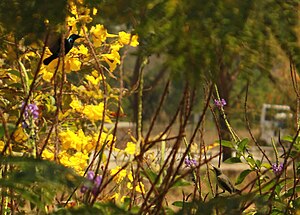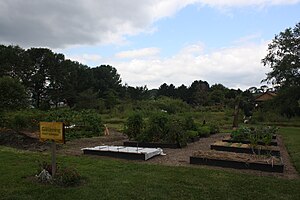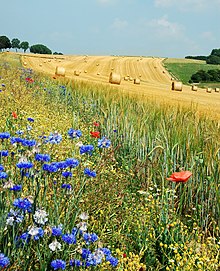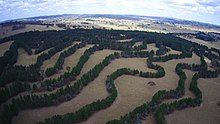Regenerative agriculture
Regenerative agriculture (RA) is an approach to food and farming systems which aims to regenerate topsoil, increase biodiversity,[1]improve water cycles,[2] enhance ecosystem services, support biosequestration, increase resilience to climate fluctuation, and strengthen the health and vitality of farm soil, by recycling as much farm waste as possible, as well as adding compost material from outside the farm.[3][4][5][6]
Regenerative agriculture on small farms and gardens is often based on ideologies like permaculture, agroecology, agroforestry, restoration ecology, Keyline design and holistic management, whereas large farms tend to be less ideology driven, and often utilize "no till" and/or "low till" aided by the use of herbicide tolerant genetically modified seed.
Ideally, on a regenerative farm, yield production should grow more ample over time. As the soil deepens, yields may increase and external composting inputs decrease. Actual output is however dependent on the nutritional value of the composting materials, and the nutritional status of the soil. [7] [8]
Contents
Roots[edit]
Regenerative agricuture is based on various agricultural and agroecologic practices, and a particular emphasis is on minimal soil disturbance and the practice of composting. [9]Maynard Murray (1910–1983)had similar ideas, but with sea minerals. [10] [11] [12] [13] Her work led to other innovations in no-till practices, such as slash and mulch in the tropics. [14]
[15] [16] [17] </ref> The lasagna method feeds the soil biota from above and encourages the soil food web to do the work of aerating and mixing the nutrients into the soil below.[18] [19] They created a video, Farming With Nature: A Case Study of Successful Temperate Permaculture.[20]
Microbiologist Elaine Ingham popularized the importance of soil health and the soil food web.[21]
In the 1980s, the Rodale Institute began using the term ‘regenerative agriculture’.[23] Rodale Publishing formed the Regenerative Agriculture Association, which published books in 1987 and 1988.[24]
However, the Institute stopped using the term in the late 1980s and it appeared sparingly (in 2005[25] and 2008) until they released a white paper titled "Regenerative Organic Agriculture and Climate Change" in 2014.[26] Its summary states, “we could sequester more than 100% of current annual CO2 emissions with a switch to widely available and inexpensive organic management practices, which we term 'regenerative organic agriculture.'” The agricultural practices described are crop rotation, compost application and reduced tillage,[26] similar to most organic agriculture.
From 1990 to 2010, RA was most explicitly practiced within the permaculture community. Influenced by Carol Sanford and the design and development work of Regenesis,[27] the ecological systems approach of permaculture led regenerative agriculture to incorporate whole farm design, multi-story agroforestry and rotational livestock integration.[28]
Author and restorative development consultant Storm Cunningham (b. 1951) documented the rise of what he then called "restorative agriculture" in his first book, The Restoration Economy. He defined it as a technique that rebuilds the quantity and quality of topsoil while restoring local biodiversity (especially native pollinators) and watershed functionality. Carbon sequestration has more recently been added to that definition, to help achieve climate restoration. Restorative agriculture was one of the eight sectors of restorative development industries / disciplines in The Restoration Economy's taxonomy. The other seven were watershed restoration, ecological restoration, fisheries restoration, brownfields remediation, heritage restoration, infrastructure renewal and catastrophe reconstruction. [29]
2010s onward[edit]
This section may rely excessively on sources too closely associated with the subject, potentially preventing the article from being verifiable and neutral. (November 2018) (Learn how and when to remove this template message)
|
Sheep grower, historian, regenerative agriculture consultant and advocate Charles Massy published Call of the Reed Warbler: a new agriculture - a new earth, based on his PhD studies.[30] The book frames regenerative agriculture as a savior for the earth using case studies.[31]
Darren J. Doherty (1967-) founded Regrarians Ltd. in 2013, a non-profit promoting RA.[32]His Regrarians Platform extends Yeomans’ 'Keyline Scale of Permanence', layering social and economic lenses on top of the original agricultural ones.[33] They include climate, geography, water, access, forestry, buildings, fencing, soils, economy and energy.
John Ikerd advocates for the "small" family farm and farmers and for sustainability in the US food system.[34] Ikerd is author of The essentials of economic sustainability,[35] Small Farms are Real Farms: Sustaining People through Agriculture[36] and Sustainable Capitalism (2005).[37]
Vermont farmer and farm consultant Abe Collins created LandStream to monitor ecosystem performance in RA farms.[38]
Mark Shepard founded New Forest Farms in Viola, Wisconsin, and Forest Agriculture Enterprises and wrote Restoration Agriculture: Real World Permaculture for Farmers. He demonstrated how to grow more calories per acre than corn and soy without inputs. He does this through a mix of RA practices, balancing nut crops, livestock and keyline.
Ethan Roland Soloviev and Gregory Landua, cofounded Terra Genesis International (a regenerative agriculture and supply company), published Levels of Regenerative Agriculture (2016). In this paper, they describe a four-fold framework consisting of:
- Functional Regenerative Agriculture: "humans can do good through their agricultural production"
- Integrative Regenerative Agriculture: "grow the health and vitality of the whole ecosystem"
- Systemic Regenerative Agriculture: "farms are woven into an ecosystem of enterprises operating in their bioregion"
- Evolutionary Regenerative Agriculture: "harmonize with the potential of a place," and "develop a diversity of global and local regenerative producer webs"
Permaculture designer and researcher Eric Toensmeier[39] wrote The Carbon Farming Solution: A Global Toolkit of Perennial Crops and Regenerative Agriculture Practices for Climate Change Mitigation and Food Security (2016).[40] Toensmeier claimed that regenerative practices hold the potential to sequester massive amounts of CO
2 into the soil, all while providing adaptive and resilient solutions given a changing climate.[41]
2 into the soil, all while providing adaptive and resilient solutions given a changing climate.[41]
Principles and practices[edit]
Regenerative agriculture is guided by a set of principles and practices.[5]
Principles[edit]
- Increase soil fertility
- Work with wholes, not parts
- Progressively improve whole agro-ecosystems (soil, water and biodiversity)
- Connect the farm to its larger agroecosystem and bioregion
- Create context-specific designs and make holistic decisions that express the essence of each farm
- Express the essence of each person, farm and place
- Make holistic decisions aimed at specific systems change
- Ensure and develop just and reciprocal relationships among all stakeholders
- Design for non-linear, multi-capital reciprocity
- Continually grow and evolve individuals, farms and communities to express their potential
- Continually evolve agro-ecological processes and cultures
- Agriculture shifts the world
Practices[edit]
- Permaculture Design
- Agroforestry[3]
- Soil Food Web
- Properly Managed Livestock, Well-managed grazing,[5] Animal Integration,[3] and Holistically Managed Grazing[3]
- STUN (Sheer, Total and Utter Neglect) Breeding[44]
- Keyline Subsoiling
- Conservation farming, No-Till Farming, minimum tillage,[5] and Pasture Cropping[3]
- Cover crops & multispecies cover crops[5]
- Organic Annual Cropping[3] and Crop rotations[5]
- Compost, Compost Tea,[3] animal manures[5] and Thermal Compost
- Natural sequence farming
- Grassfed livestock
- Polyculture and full-time planting of multiple crop intercrop plantings[5]
- Borders planted for bee habitat and other beneficial insects[5]
- Biochar/Terra Preta[3]
- Ecological Aquaculture[3]
- Perennial Crops[3]
- Silvopasture[3]
See also[edit]
- Agroecological restoration
- Agroecology
- Agroforestry
- Biointensive agriculture
- Carbon farming
- Farmer-managed natural regeneration
- Permaculture
- Regenerative Design
References[edit]
- ^ "Our Sustainable Future - Regenerative Ag Description". www.csuchico.edu. Retrieved 2017-03-09.
- ^ Underground, The Carbon; Initiative, Regenerative Agriculture; CSU (2017-02-24). "What is Regenerative Agriculture?". Regeneration International. Retrieved 2017-03-09.
- ^ a b c d e f g h i j k l m "Regenerative Agriculture". regenerativeagriculturedefinition.com. Retrieved 2017-03-07.
- ^ "Regenerative Agriculture | Regenerative Agriculture Foundation". regenerativeagriculturefoundation.org. Retrieved 2017-03-09.
- ^ a b c d e f g h i j k "Definition — The Carbon Underground : The Carbon Underground". thecarbonunderground.org. Retrieved 2017-03-07.
- ^ "Regenerative Organic Agriculture | ORGANIC INDIA". us.organicindia.com. Retrieved 2017-03-09.
- ^ Falk, Ben (2013). The Resilient Farm and Homestead: An Innovative Permaculture and Whole Systems Design Approach. Chelsea Green Publishing. p. 280. ISBN 978-1-60358-444-9.
- ^ "Dr. William A. Albrecht - IFOAM". www.ifoam.org.
- ^ Hensel, Julius. Bread From Stones: A New and Rational System of Land Fertilization and Physical Regeneration. Republished by Acres USA, Austin, Texas, 1991. 102p.
- ^ Murray, Maynard. Sea energy agriculture. 2nd ed. revised. Austin, TX: Acres, USA, 2003. vii, 109p. Nauta, Phil. Building soils naturally. Austin, TX: Acres, USA, 2012. xvi, 303p.
- ^ Howard, Sir Albert. An Agricultural Testament. London: Oxford University Press, 1943.
- ^ Balfour, Lady Eve. 9,600 Miles Through The U.S.A. in a Station Wagon. London: The Soil Association, 1954.
- ^ Stout, Ruth. Gardening without Work.
- ^ Yeomans, P.A. The Australian Keyline Plan. Sydney: P.A. Yeomans, 1954. [Source: The Holistic Agriculture Library and The Challenge of Landscape - The Development and Practice of Keyline. Sydney: Keyline Publishing PTY, Ltd., 1958. [Source: The Holistic Agriculture Library]
- ^ Fukuoka, Masanobu et. al. The One-Straw Revolution: An Introduction to Natural FarmingNew York Review Books, 2009 and Natural Way of Farming: The Theory and Practice of Green Philosophy. Other India Press, 1985. 284p.
- ^ Hamaker, John D. and Donald Weaver. The Survival of Civilization. Hamaker-Weaver Publishers, 1982. 234p. Reprinted, 2002.
- ^ Whatley, Booker T. How to Make $100,000 Farming 25 Acres. Emmaus, Pennsylvania, Regenerative Agriculture Association, 1987. 180 pages.
- ^ Lanza, Patricia. Lasagna Gardening: A New Layering System for Bountiful Gardens: No Digging, No Tilling,No Weeding, No Kidding! Rodale Books, 1999. 256p.
- ^ Holzer, Sepp. Sepp Holzer's Permaculture: A practical guide to small-scale, integrative farming and gardening. White River Junction, VT: Chelsea Green Publishing, 2011. xix, 246p.
- ^ ecofilm (15 August 2009). "PERMACULTURE - CULTIVER AVEC LA NATURE - Sepp Holzer TRAILER" – via YouTube.
- ^ Ingram, Elaine. (2000) Soil Biology Primer. USDA.
- ^ Mollison, Bill. Permaculture: A Designer's Manual. Tagari Publications, 1988. 576p; Holmgren, David. Permaculture: Principles and Pathways beyond Sustainability. Holmgren Design Services, 2002. 320p. .
- ^ "AFSIC History Timeline | Alternative Farming Systems Information Center| NAL | USDA". Retrieved 2017-03-09.
- ^ "Tracing the Evolution of Organic / Sustainable Agriculture (TESA1980) | Alternative Farming Systems Information Center| NAL | USDA". Retrieved 2017-03-09.
- ^ "A truly regenerative agriculture | Rodale Institute". rodaleinstitute.org. Retrieved 2017-03-09.
- ^ a b "Regenerative Organic Agriculture and Climate Change | Rodale Institute". rodaleinstitute.org. Retrieved 2017-03-09.
- ^ Regenesis Group, 2016. Regenerative Development and Design: A Framework for Evolving Sustainability: Wiley Publishing, Hoboken, NJ.
- ^ Mollison, B. 1988. Permaculture: A Designers Manual: Tagari Press, ISBN 0-908228-01-5.
- ^ Cunningham, Storm. The Restoration Economy. Berrett-Koehler Publishers, 2002. 340p.
- ^ Massy, Charles (2017). Call of the reed warbler: a new agriculture- a new earth. Queensland University Press.
- ^ "Author talk with Charles Massy call of the reed warbler". Trove.
- ^ "Darren J. Doherty CV – Regrarians". www.regrarians.org. Retrieved 2017-03-06.
- ^ "The Regrarians Platform® – Regrarians". www.regrarians.org. Retrieved 2017-03-06.
- ^ "Home". www.johnikerd.com.
- ^ The essentials of economic sustainability Lynne Rienner Publishers, 2012.
- ^ "Small Farms Are Real Farms". Acres USA.
- ^ Sustainable Capitalism: A Matter of Common Sense. Lynne Rienner Publishers, 2005.
- ^http://harvardforest.fas.harvard.edu/sites/harvardforest.fas.harvard.edu/files/grazing/Collins_Harvard%20Forest%202.pdf
- ^ "» Books, Articles, and DVDs". Perennial Solutions. Retrieved 2017-03-16.
- ^ "Book Review: The Carbon Farming Solution - Ecological Landscape Alliance". www.ecolandscaping.org. Retrieved 2017-03-16.
- ^ Toensmeier, Eric (2016). The Carbon Farming Solution. White River Junction, Vermont: Chelsea Green. ISBN 978-1-60358-571-2.
- ^ Soloviev, E. and Landua, G. Levels of Regenerative Agriculture. Terra Genesis International, High Falls, NY, 2016.
- ^ "The 9 Most Important Techniques In Regenerative Agriculture". Archived from the original on 2017-03-08. Retrieved 2017-03-07.
- ^ "Mark Shepard's Proven Technique - "Sheer, Total, and Utter Neglect"". 7 June 2013.







 Photo by
Photo by 



 See this image
See this image